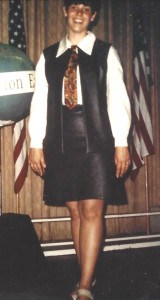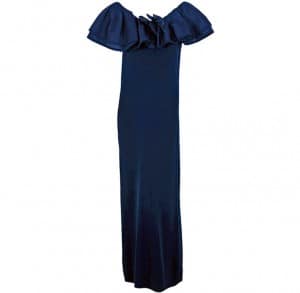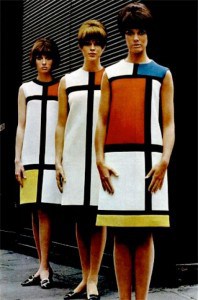Innocent and Blithe: 1960s Fashion
By Alice Askins, Education Coordinator at Rose Hill Mansion,
Recently, a friend mentioned that he had asked a group of young people what came to their minds when they thought of the 1960s. “Hippies,” is what I thought, since I enjoy clothing, and hippies certainly had their own style. In this post, though, I want to talk about mainstream 1960s fashion. So let’s start by going back a little.
Women’s clothing of the 1950s hugged the torso and emphasized the waistline. Skirts were long. In the late 1950s some designers (Balenciaga, for one) showed sack dresses that de-emphasized the curves of the figure. Here’s how the Geneva Times saw it in January 1960:
PARIS (AP) — Fashion designer Pierre Balmain today showed a “Greek column” line, slim and semi-slack at the waist . . . While Balmain’s dresses were not in full, sexy style, they were a great distance from the sack that hid feminine charm. . . .
The slim dress that ignored the waist became known as the shift, and it was a very popular shape in the 1960s. Around the same time, pants and skirts shrank down from the waist and became hip-huggers. Low-rider pants and skirts, with a shirt tucked into them, gave much the same shape that shifts did. Skirts also started to shorten in the early 1960s, so the ideal female silhouette was leggy and slim. It was more a little-girl look than a sexy look, and it suggested freedom and motion.
 Americans saw the shift as part of the London Look, also called Mod. The Beatles and other English bands made England exciting, and brought fashion as well as music to the United States. McCurdy’s of Geneva ran an ad in the Geneva Times in August 1965:
Americans saw the shift as part of the London Look, also called Mod. The Beatles and other English bands made England exciting, and brought fashion as well as music to the United States. McCurdy’s of Geneva ran an ad in the Geneva Times in August 1965:
Shift Into The London Look
It’s fun shifting into the new season, especially now that the new London look has shifted into town. Here’s just one version to delight the Mod set: Innocently chic, blithely carefree in rayon-and-cotton. . . .
References to the London Look appear in local ads throughout the decade. In December 1965 – “New scents such as “Oh! de London” fit in with the Mod look. By Yardley.” March 1967 – “Now have eyes twice their size! Just put on Yardley’s English Eyes, The new London Look collections – English Eyelighter . . .London Lashes . . . Do hurry in, luv. . .” July 1969 – “New Beauty Idea from London! The leggy London look is in. And thousands of London girls are wearing the sandals that help make it such a fashion sensation. Scholl Exercise Sandals. . . .” (Just as a matter of interest, Dr. Scholl started in Chicago.)
 We responded to the appeal. To the left is our friend Nancy in a Mod outfit she made in 1969. Unfortunately, the photo cuts off her London newsboy cap, but it is still clear that she was very chic.
We responded to the appeal. To the left is our friend Nancy in a Mod outfit she made in 1969. Unfortunately, the photo cuts off her London newsboy cap, but it is still clear that she was very chic.
Men were not excluded from all this fun. The Times reported in March 1960 that “Not satisfied with keeping the ladies in a dither, Paris designer Pierre Cardin has turned his sights on the men. . . he has raised the necks on these ready-to-wear suits. The short, tight-fitted jackets button all the way up to the Adam’s apple and are lapelless. Cuffless pipestem pants complete the outfits.”
The Auburn Pants Store in Geneva ran the following ad in May 1966:
Our Modnick styles for h.i.s. are jolly right for spring. h.i.s. took the London Look and shook the U.S.A. So, shake it up, baby. Make it in Modnicks!
MODNICK SLACKS swing low with a wide belt and flashing buckle. They travel tight to the knee and then take the straight road to stovepipe fashion. Choose from way-out colors and fabrics. 5.00 – 7.00
MODNICK SHIRTS are mad, mad with bandless button-down collars that roll into longer-than-ever points. . . . In solids and patterns, smashing new colors and fabrics. 4.00
Though influential, the London Look was only part of the 1960s fashion picture. There was “space” clothing, for instance, reflecting the space race between the US and the USSR. Designers like Courreges, Cardin, and Rabanne were known for futuristic styles. They used a lot of silver and white, and combined geometric shapes with new synthetic fabrics. Accessories were often boots, goggles, and helmets (loosely based on astronaut wear.)
Art also influenced 1960s fashion. Yves Saint Laurent, for example, channeled the Dutch painter Mondrian for his 1965 collection, and Op Art patterned a lot of 1960s clothing.
These trends tended to come from the top down. That is, designers and fashion icons leading the rest of us. The 1960s, though, also found ordinary people making influential decisions about clothing. Women, for example, wearing pants more of the time (and causing a fair amount of editorial and sociological agonizing about men’s and women’s roles.) And then there were those hippies. Next up, 1960s anti-fashion.




